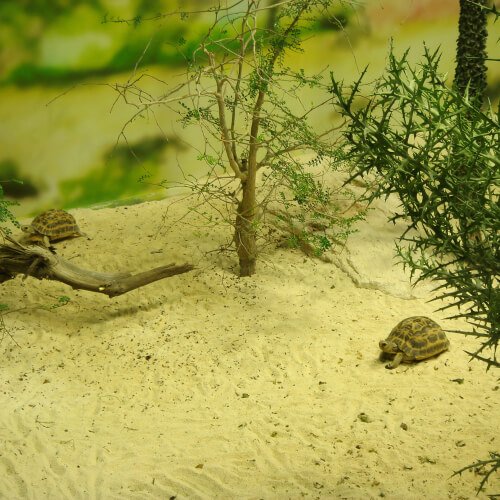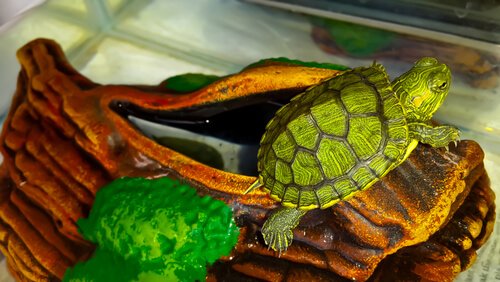Make a Terrarium for Your Turtle


Written and verified by the lawyer Francisco María García
Turtles are very curious animals and are excellent first pets for children. However, before adopting a turtle as a pet, you need to prepare your home for its arrival, especially giving them a terrarium.
A terrarium for your turtle is one of the most important items to bring home because that’s where the reptile will spend most of its day. Although there are some models at the store, we’ll show you how to make a homemade terrarium for your turtle.
Materials that are necessary for making a terrarium for your turtle
Below are the tools and elements you’ll need to make a terrarium:
- Container/aquarium: this is a glass container or an aquarium that can also be used as a terrarium for turtles. It’s rectangular and noticeably wider than it is long.
Since it’s designed for all turtles (aquatic and terrestrial), the container will also have some dry regions. That’s where the reptile can sunbathe, dry, gather heat for their body and rest.

- Filter: filters are essential to keep you turtle’s terrarium’s water in good condition. There are several types of water filters made for aquariums and terrariums. We recommend talking to a specialist at a pet store in order for you to know which will be best for your turtle’s terrarium.
- Heating system: just like the filter, the heater is a crucial element for making sure your turtle has a good quality of life (both aquatic and semi-aquatic). It’s also a good idea to have a thermometer to check the water temperature periodically and to avoid any issues.
Remember that the cold can harm the health of your turtle, while excessive heat favors the growth of algae and pathogenic microorganisms.
- Special turtle lamp: like all reptiles, turtles need solar radiation to regulate their body temperature and to synthesize essential nutrients. So, in addition to watching the water temperature, you should also provide a dry area with a good amount of light.
- Decorative items: Decorations not only make the terrarium look good, but it also recreates the turtle’s habitat. This has a very positive impact on the physical and mental well-being of reptiles. The most common decorations are branches and stones, and you can even add natural or artificial plants.
- Sand for terrariums: the sand will be the floor of your turtle’s terrarium and it will help imitate the sea or rivers.

Step by step how to build a terrarium for your turtle
- 1. Before starting your turtle’s terrarium, make sure you wash the container well to remove any dirt inside. Avoid using corrosive or irritating products when cleaning the container.
- 2. It’s a good idea to use warm water and neutral soap to wash the container. Rinse with plenty of water and leave some warm water inside for 30 to 60 minutes.
- 3. When the terrarium is clean and dry, start to install the filter. To place it correctly, you’ll want the water to come out through the fall at a distant that’s further from the container’s walls. That will allow for better water circulation in your turtle’s terrarium.
- 4. Next, start to install the heating system on one side of the terrarium. Ideally, you should make sure its location doesn’t interfere with the filter system and doesn’t mess with the aesthetics of the terrarium.
- 5. The next step is to coat the bottom of the container with special sand made for turtle aquariums. To cover it well and to give it some depth, use a layer that’s three to four centimeters thick.
- 6. Now it’s time to be creative and decorate the terrarium. We recommend putting some branches on the sand at the bottom of the aquarium. Then, you can place some stones in the dry regions, which will help your turtle gather heat and dry off.
- 7. Now, fill the terrarium with water (if it’s an aquatic or semi-aquatic terrarium). You don’t want to do this abruptly all at once because it will ruin your decorations.
- 8. Gradually add the water, at room temperature, until it almost reaches the dry regions. Of course, make sure to clean, drinking water in order to preserve your turtle’s health.
- 9. Finally, install the turtle lamp and make sure it’s pointing at the dry region. Be careful that you don’t put it too close because this could harm your turtle’s skin and cause burns. Ideally, it should be about 30 centimeters away.
When your turtle’s terrarium is ready, it’ll be time to find the perfect location in your home. Make sure to choose a clean and quiet room that will aid in your pet’s development. Remember to always keep it in a safe environment that is away from any harmful elements.
Turtles are very curious animals and are excellent first pets for children. However, before adopting a turtle as a pet, you need to prepare your home for its arrival, especially giving them a terrarium.
A terrarium for your turtle is one of the most important items to bring home because that’s where the reptile will spend most of its day. Although there are some models at the store, we’ll show you how to make a homemade terrarium for your turtle.
Materials that are necessary for making a terrarium for your turtle
Below are the tools and elements you’ll need to make a terrarium:
- Container/aquarium: this is a glass container or an aquarium that can also be used as a terrarium for turtles. It’s rectangular and noticeably wider than it is long.
Since it’s designed for all turtles (aquatic and terrestrial), the container will also have some dry regions. That’s where the reptile can sunbathe, dry, gather heat for their body and rest.

- Filter: filters are essential to keep you turtle’s terrarium’s water in good condition. There are several types of water filters made for aquariums and terrariums. We recommend talking to a specialist at a pet store in order for you to know which will be best for your turtle’s terrarium.
- Heating system: just like the filter, the heater is a crucial element for making sure your turtle has a good quality of life (both aquatic and semi-aquatic). It’s also a good idea to have a thermometer to check the water temperature periodically and to avoid any issues.
Remember that the cold can harm the health of your turtle, while excessive heat favors the growth of algae and pathogenic microorganisms.
- Special turtle lamp: like all reptiles, turtles need solar radiation to regulate their body temperature and to synthesize essential nutrients. So, in addition to watching the water temperature, you should also provide a dry area with a good amount of light.
- Decorative items: Decorations not only make the terrarium look good, but it also recreates the turtle’s habitat. This has a very positive impact on the physical and mental well-being of reptiles. The most common decorations are branches and stones, and you can even add natural or artificial plants.
- Sand for terrariums: the sand will be the floor of your turtle’s terrarium and it will help imitate the sea or rivers.

Step by step how to build a terrarium for your turtle
- 1. Before starting your turtle’s terrarium, make sure you wash the container well to remove any dirt inside. Avoid using corrosive or irritating products when cleaning the container.
- 2. It’s a good idea to use warm water and neutral soap to wash the container. Rinse with plenty of water and leave some warm water inside for 30 to 60 minutes.
- 3. When the terrarium is clean and dry, start to install the filter. To place it correctly, you’ll want the water to come out through the fall at a distant that’s further from the container’s walls. That will allow for better water circulation in your turtle’s terrarium.
- 4. Next, start to install the heating system on one side of the terrarium. Ideally, you should make sure its location doesn’t interfere with the filter system and doesn’t mess with the aesthetics of the terrarium.
- 5. The next step is to coat the bottom of the container with special sand made for turtle aquariums. To cover it well and to give it some depth, use a layer that’s three to four centimeters thick.
- 6. Now it’s time to be creative and decorate the terrarium. We recommend putting some branches on the sand at the bottom of the aquarium. Then, you can place some stones in the dry regions, which will help your turtle gather heat and dry off.
- 7. Now, fill the terrarium with water (if it’s an aquatic or semi-aquatic terrarium). You don’t want to do this abruptly all at once because it will ruin your decorations.
- 8. Gradually add the water, at room temperature, until it almost reaches the dry regions. Of course, make sure to clean, drinking water in order to preserve your turtle’s health.
- 9. Finally, install the turtle lamp and make sure it’s pointing at the dry region. Be careful that you don’t put it too close because this could harm your turtle’s skin and cause burns. Ideally, it should be about 30 centimeters away.
When your turtle’s terrarium is ready, it’ll be time to find the perfect location in your home. Make sure to choose a clean and quiet room that will aid in your pet’s development. Remember to always keep it in a safe environment that is away from any harmful elements.
All cited sources were thoroughly reviewed by our team to ensure their quality, reliability, currency, and validity. The bibliography of this article was considered reliable and of academic or scientific accuracy.
- Wappel, S. M., & Schulte, M. S. (2004). Turtle care and husbandry. Veterinary Clinics: Exotic Animal Practice, 7(2), 447-472.
- Lutz, C. G. (2000). Pet turtle production. Stoneville, MS: Southern Regional Aquaculture Center.
- Schulte, M. S., & Rupley, A. E. (2004). Exotic pet management for the technician. Veterinary Clinics: Exotic Animal Practice, 7(2), xi-xii.
This text is provided for informational purposes only and does not replace consultation with a professional. If in doubt, consult your specialist.








